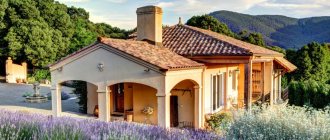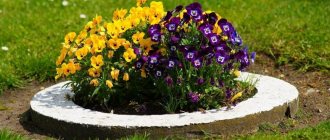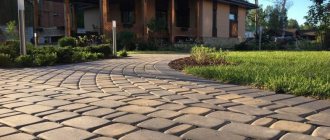Paths in the garden, in addition to their practical functions, harmoniously complement the landscape design of the garden plot. Laying out walking routes through country estates is, of course, a serious matter, but the picture would remain unfinished without the final, but extremely important, touches. Today we bring to your attention three landscape-style sketches that you can use to design paths in your own garden. For each option, we will show you a planting scheme, their photos and names by height, flower color and flowering period.
Rules for creating a border of flowers
When creating a flower border next to a path, you should adhere to a number of principles. First of all, this applies to the choice of plants. For example, by planting without taking into account growth, after a while you may end up with an impassable path overgrown with greenery.
Flower garden path fencing Source zen.yandex.ru
To avoid these and other troubles, use these tips:
- Contrast of plants used for edging purposes with flower garden plantings.
- Plant low-growing perennial plants with reserve for subsequent growth.
- You can avoid unsightly gaps in the path hedge by planting 2 rows of plants.
- Give preference to slow-growing plants. This will reduce the likelihood of overgrown lashes falling apart in different directions and will make the frame look neat and tidy.
Advice! Stick to the classic sizes of living flower borders: no more than 500 mm. in width, and 400 mm. in height. However, these conditions can be violated based on the location of application and garden design.
Shrubs and trees along the fence
Very often, summer residents place trees and shrubs along the fence.
Trees and shrubs along the fence Source gardencreator.net
The most unpretentious of trees: mountain ash, hawthorn, fir, pine Source samstroy.com
When planting tall seedlings, their growth should be taken into account, so they are planted at a distance of 3-5 meters from the house, otherwise they can damage the foundation of the building.
More often, dogwood, elderberry, hydrangea, and dogwood bushes are located next to the fence. When planting the latter, take into account that it does not get along with barberry.
On the outside of the fence, it is customary to plant decorative species of shrubs that can create a hedge.
These can be rose hips, viburnum, bird cherry bushes Source wallpaperup.com
What to plant along the path in the country
Low-growing plants as a frame for a winding sidewalk Source zen.yandex.ru
The choice of plants for a flower garden along the path is done with an eye on the characteristics of the area being landscaped. It is most rational to use decorative seedlings that are suitable for different areas, regardless of the size and layout of the territory. At the first stage, a planting plan is drawn up taking into account the following factors:
- The purpose of plantings: protection, beauty or shading of the local area.
- Distance to external fence. Its shape, the material from which it is made, airflow. In the future, plants should not interfere with the approach in case of repair or painting.
Advice! When creating a flower garden along the path, give preference to plants of different types that differ in flowering periods. Such combinations are called mixborders.
See also: Catalog of companies that specialize in landscaping work on sites.
Mixborder scheme
Plant tall plants up to 1.5 meters in height closest to the fence. These are rudbeckia, asteraceae, foxgloves and other perennials with large flowers and leaves.
When selecting flower arrangements, designers usually arrange two or three crops of different flowering periods together so that the fence does not look bare.
Secondly, medium-sized plants are planted. This row creates the splendor of the entire composition, so plants are chosen for it that, even after flowering, do not lose their attractiveness.
These can be pinesettum, chrysanthemums, lavender Source sewerge.ru
Lastly, form the border of the flower bed. Ground cover plants are best suited for this. For example, spirea, nasturtium, cornflowers.
An example of a mixborder scheme Source krapivada.ru
List of low-growing plants
Colorful landscape of a garden plot with differences in elevation Source www.rutvet.ru
An impressive list of low-growing flowers, thanks to which a beautiful flower bed is organized along the garden path, is conventionally divided into several categories:
- Ground cover.
- Herbaceous.
- Conifers.
- Beautifully blooming.
They can also be perennial or annual, that is, the latter will have to be renewed every spring.
Garden path in combination with plants of different varieties Source www.tsvetnik.info
As an example of the correct organization of a flower bed along a path, let’s consider several different varieties, the use of which will advantageously embellish any flower bed:
- Sedum (sedum) – grows no more than 15 cm in height. Able to withstand serious influences: drought, abundance of moisture, human attack. There are different varieties, differing in size and color of the leaves.
- Scottish moss - does not “rise” above 3 cm. Prefers warm, shaded areas, average watering. It is preferable to plant on the eastern side of the site, where the plant will receive protection from ultraviolet radiation.
- Juniper horizontalis is a slow-growing plant of the coniferous groundcover family. Does not rise above the ground above 4-5 m. The color of the needles in the warm season is silver-blue, in winter - with a purple tint.
- Wild, elfin, and Breckland thyme (creeping) blooms in late May - early June. The shoots, crowned with light purple flowers, do not stretch upward, but spread along the ground, emitting a sweet fragrance.
- Garden chamomile is an unpretentious plant with healing properties. Prefers a cool, dry environment and grows in any type of soil.
- Viola creeping (Loosestrife) – the purple small flowers of the plant harmonize perfectly with paving stones and steps. Creates a strong green frame in early spring, maintaining it until late autumn. Planting this plant as a frame for a flower bed attracts a large number of butterflies.
- Veronica creeping - blooms with blue or white flowers 2-3 times during the summer season. Prefers plenty of sun, but does not die in shaded areas.
Rabitz
An unpretentious dacha fence made of metal mesh with good coverage and metal posts can last for decades. By skillfully selecting the dominant plant, it can be made impenetrable at almost any time of the year.
Using mesh material as a fence allows you to plant climbing plants
Summer residents prefer to plant lilac, shadberry, chokeberry or barberry bushes along the mesh fence, from which flowering branches or fruits can be picked for medicinal purposes. However, this is not the best way out of the situation, because the shrub requires periodic renewal, and during the period when it does not bloom or bear fruit, it is a dull green mass.
If you form the bush correctly and leave it on the trunk in the form of a crown, a shady flower bed of perennials or unpretentious ornamental plants that climb and prefer to grow in the shade is an excellent way out of this situation. Craftsmen manage to build a kind of rock garden or rock garden from a narrow strip of land under bushes, combining the texture of natural stone and low plants.
The photo below shows the courtyard of a private house.
Rock garden goes well with the landscape
The second way to create a flowerbed under the chain-link with your own hands, if the shrub has not yet been planted, is climbing ornamental plants with a high degree of productivity of green mass. In such cases, it is recommended to plant bindweed, climbing roses, honeysuckle, virgin grapes and white dogwood.
Flower garden arrangement diagram
If a person intends to limit himself to a one-time event, the absolute way to create a flower garden under the chain-link is male dogwood. In addition to picturesque shady thickets, flowers with a pleasant aroma and berries, it has another undeniable advantage - it lives for about 200 years.
Tall flowers
A winding path bordered by rich greenery Source www.botanichka.ru
For floral edging of the border of a garden path, plants with a height not exceeding 40-50 cm are used. As an example, consider options for using annual representatives of this group:
- Ageratum Houston (Mexican) is a heat-loving variety, planted after the threat of night frosts has passed. The plant blooms in lush baskets of small flowers in pink, blue, and purple shades. Creates a lush surface, the height of which is adjusted by pruning the shoots. Recovers in a few days. It blooms in early June and remains in this fragrant state until the first frost.
- Salvia (sage) - the flower reaches a height of up to 50 cm. For border frames, low-growing varieties are used: “Fireball”, “Vesuvius”. It is grown only through seedlings. The bright red flowers of the plant harmonize perfectly with the miniature yellow leaves of marigolds or silvery ciniririums.
Beautiful perennials Source flo.discus-club.ru
- Hybrid nasturtium - the plant will decorate the landscape design of the garden not only with voluminous, rich flowers of light yellow or fiery red, but also with original leaves. Large, rounded, suspended cuttings look impressive. To decorate the border of a flower bed, bush varieties are used: “Strawberries with Cream” and “Jewel Mix”; species with unusual variegated leaves are also used: “Alaska Golden”, “Alaska Scarlett”.
- Coreopsis - yellow, orange or golden flowers on a thin stalk can be planted in open ground. For this purpose, the Crimson King variety is used, reaching a height of 30 cm.
Mixborders: photo ideas
Recently, landscape design along the fence has been organized using mixborders. These are plantings that are very diverse and bloom at different times. Thanks to these properties, mixborders look beautiful at any time of the year.
Flower arrangements can include not only low-growing plants, but also shrubs, fruit trees, climbing vines and other garden inhabitants.
When organizing this type of flower bed, the owner of the dacha must choose the plants correctly.
A landscape designer who knows the characteristics of each plant and its compatibility with its neighbors will help you cope with this. Source pinterest.com
Perennials
A bench on a garden path framed by greenery Source www.botanichka.ru
The main advantage of perennial plants in their use to create a flower garden along the path is practicality. They do not have to be planted at the beginning of each season, trembling before the start of the growing season, and preparing seeds for the next year in the fall.
- Sedum Vidny - during the flowering period reaches a height of 40 cm. It grows in abundant shoots on a thick stalk. The top is crowned with pink flowers that do not fade from the beginning of August to the end of September. It is unpretentious to soil and watering. It grows both in the shade and in well-lit areas.
- Heuchera small-flowered - the plant is used in border framing and filling high edgings. An evergreen perennial with large green or dark purple leaves extending no higher than 15-20 cm above the soil. The flower joints rise on a long, rigid stalk, holding small cream or pink flowers.
- Narcissus - used for early decoration. The bulbous plant blooms in mid-April, retaining its petals until the May holidays. It is found with snow-white or yellow petals with a golden stamen. It is unpretentious to soil and grows well both in the shade and in the sun. However, in warmer areas, where the snow melts first, it rises faster.
Asphalt path with flower beds instead of borders Source flo.discus-club.ru
- Lavender - fluffy, fragrant bushes are popular among herbalists who prefer natural tea. Bright purple spikelets in the border of a garden path look impressive, but require regular care. Growing will require periodic loosening of the soil, regular watering, fertilization, and preparation for winter. The plant also prefers sunny, draft-free places and vapor-permeable soils saturated with an alkaline reaction.
- Cinquefoil (shrub cinquefoil) - the plant is used to create a flower border in white, yellow or red. It does not exceed 1 m in height. It blooms at the end of May, retaining the inflorescences until the first frost. It tolerates frosts in central Russia well and is not susceptible to pests, drought, or soil conditions. Care is required only in spring: dry, weak shoots are pruned in March-April.
- Mussolini's catnip is an ideal option for rocky, infertile soil. It blooms on any side, but the maximum effect of the inflorescences is achieved where they are heated by the sun's rays. It does not exceed 40 cm in height, has an original blue-lilac hue, and blooms throughout the summer season.
Original landscape design Source happymodern.ru
Important! A significant disadvantage of perennial plants in flower beds along paths is their short flowering period compared to annuals.
Option 1. Flowerbed of hydrangea, spirea and juniper
Place Japanese spirea and ground cover roses closer to the edge of the flower bed. Between them is juniper, it serves as a kind of dividing “layer” between two shrubs blooming at the same time. To give the flower garden a more solemn look and create a symmetry effect, tall plants with a pyramidal crown are planted along the fence. The basis of this composition is made up of paniculata hydrangea bushes located in the center. Plant Douglas spirea bushes on the sides, behind them, on both sides of the flower bed, pyramidal thujas.
- Flowerbeds of continuous flowering - diagrams with descriptions of flowers
We answer questions about where to place a flower garden and what plants to plant in order to admire lush blooms from spring to autumn.
What flowers to plant along the paths so that they bloom all summer
Saturation of flowers and greenery Source fishing-caravan.ru
A competent choice of plants will allow you to create a flowerbed border that blooms throughout the summer. To do this, there is no need to devote a lot of time to floriculture. It is enough to use seedlings that can please the eye for several months:
- Dimarphotheca (Cape marigold) is an unpretentious annual plant with flowers of various colors: yellow, apricot, orange, pink, lilac, blue. It blooms in the first half of June, retaining tender buds until the end of August. It reaches a height of 60 cm.
- Cosmea - plant flowers are found in almost all city flower beds. A unique plant that can grow in any conditions: absolute drought and lack of watering, full shade, open sun, on any type of soil. Propagates by self-sowing.
- Eschscholzia califirnia - blooms in the first half of June, fades in early October. Bright red, rich flowers are obtained when planted in well-lit areas; it prefers sandy soils and does not require additional feeding. Propagates by self-sowing.
- Antirrinum (Snapdragon) - has bright flowers of unusual shape with a rich palette of different shades. The color of the plant can be pink, yellow, red, beige, blue, cyan, two or three colors. Branched shoots, rising no more than 60 cm, are united into pyramidal bushes. They are crowned with numerous inflorescences distributed throughout the height. It does not tolerate winter well, so it is often used as an annual.
Framing the garden path with low-growing shrubs Source classpic.ru
Types of flower beds for decoration
Annual plants grown with your own hands will help you quickly and inexpensively update your design, create a new mood, a colorful impression, and cause slight envy among passers-by and neighbors. Decorating flower beds is a special type of art, for which inspiration is not enough.
Variety of decorative options
A flower bed is a separate type of garden art, which has become especially widespread among those who try to use their own land ownership not only for utilitarian purposes.
Those who strive for independent creativity, decorativeness and creating a general impression want to make a flowerbed, occupying a minimum area, but creating the most impressive impression.
Flowerbed along the house
Of no small importance is the design of decorative structures, with the help of which you can enhance or smooth out the advantages and disadvantages of imperfect relief. A rationally planned area can be given individual characteristics using non-traditional decorative elements in garden splendor.
The variety of invented flower beds that can be placed in a dacha, grown in a previously unused area in the shade or placed on a fence is always a pleasure to capture in a photo. Even if a lot of time was spent creating this beauty, the result is worth it.
The photo shows a beautiful flower garden.
Flowerbed along the hedge
Purpose
Flower beds along the fence are multi-purpose and versatile structures. When designing a decorative component with your own hands, you don’t need to be afraid to show your imagination, carry out costly work, or create structures from stone or auxiliary materials.
Placing flower beds near the fence allows you to hide the imperfections of the fence
Thoughtful design will help:
- Disguise an unaesthetic hedge along the fence;
- close what is happening on the territory from prying neighbors' eyes;
- continue the registration of zoning or vegetation near the house;
- just add beauty to everyday life and please the eye;
- transform strips of land along the demarcation line into beautiful and cozy corners or flower plantings;
- create a single and complete image of the entire available space;
- create a soft stylistic transition from the site to a boring fence;
- just save land for gardening by creating a flower bed under the fence so you can see it from the windows of the house.
Option 4. Flower bed of filamentous yucca, geranium and Fassin's catnip
This option should be selected for sunny areas along the fence. Plant lavatera closer to the fence. It will delight with long flowering from July to October. A little further away, but in the same line or a little further from the fence, you can plant filamentous yucca. This plant is also called the “tree of happiness.” Dilute the composition with Perovka swan leaf. Fassin's catnip can be planted in the middle and foreground. If faded shoots are regularly pruned, the plant will bloom from May to September. Blood red geranium will help create a bright accent.
- Flowerbed in the sun: what flowers can grow in a dry and sunny area
Is your flower garden so open to the sun that in summer all living things literally burn out on it? Don't worry, you can deal with this by resorting to a few tricks.
Option 5. Flowerbed of balsam, aquilegia and begonia
This arrangement of plants is well suited for long but narrow (up to 1 m) flower beds. It is recommended to plant the multi-row top-fruited plant in shady flower beds on moist soils of different composition. Tuberous begonia is also a shade lover. And Waller's balsam readily develops in semi-dark areas. Hybrid aquilegia will add sophistication to the flower garden. Despite the shade-loving company, plants are watered abundantly during drought.
- What to plant in the shade near the fence: 6 plants for lovers of coniferous and deciduous crops
We choose shade-loving and shade-tolerant plants for an ever-dark corner in the garden.
Option 3. Flowerbed of clematis, astilbe and dicentra
A version of such a mixborder is perfect for an area where an unsightly chain-link mesh or other “open” fence is used as a fence, along which clematis can “crawl”. Place clematis closer to the fence, astilbe in the center in the middle ground, purple coneflower on one side of it, and foxglove behind it. On the other side of the astilbe, plant dicentra. On the next “tier”, in front of the astilbe, you can plant aquilegia and chrysanthemum. Place the shortest of the bunch in the foreground: primrose, viola, New England aster, Douglas phlox or daisies.











